Barcelona, Fustanya, Queralbs, Nuria, La Seu d'Urgell
World Trip Two
Monday, June 15, 2009: Barcelona, Spain
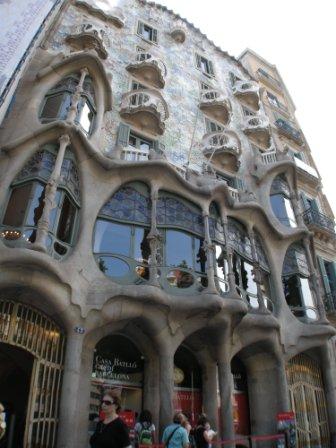 I do not find Gaudi gaudy in the least.
I do not find Gaudi gaudy in the least.
A short two-hour flight had us in Barcelona. We have only two flights left before this world trip is over; we've made ten flights so far, and there are only two remaining. This brings home how much we have done and how little there is to go. But we have saved the best for last.
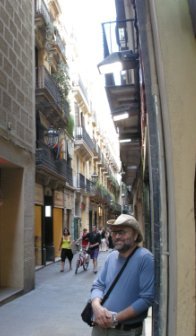 The charming old streets of Ciutat Vella.
The charming old streets of Ciutat Vella.
The sun was out and the air warm when we left our hotel to walk to the tourist information center. We were staying in the Ciutat Vella quarter, which is the oldest part of town with a history that goes back some 2,000 years! The Romans established the town of Barcino here, which was the seed for modern Barcelona. We located the first information office at Plaza Catalunya, but they did not have the particular map we were seeking. They recommended we go to the central tourist information office at Plaza Rei Joan Carlos I. We did this, stopping only for afternoon tea and to take a few photos of Gaudi's buildings along the way. The next office did not have the hiking maps of the Pyrenees either, but they suggested a little shop. This shop turned out to be very close to our hotel. So we walked back to where we had started.
The streets in the Ciutat Vella are small, quaint, cute, crooked, and ancient. The stone buildings with their verandas and shutters lean precariously into the streets below them, adding to the charm of the place. It was down one of these winding streets that we found our shop. It was something straight out of a Dickens novel - old, small, and hidden away. It was full of every kind of map, including the map we were after. Map in hand, we returned to our hotel.
Tuesday, June 16, 2009: Barcelona, Spain
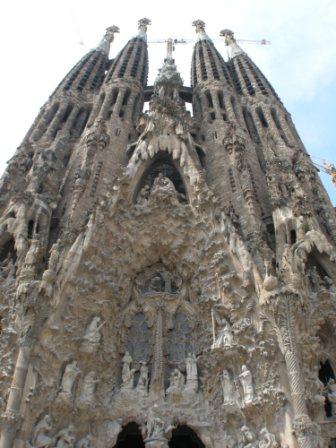 Gaudi's Temple.
Gaudi's Temple.
We headed first to Gaudi's Temple De La Sagrada Familia. This is the most amazing structure, building, and artwork I have ever seen. They started building it in 1882, and it is scheduled for completion in 2025. But there is a lot there now, and it is astounding. Gaudi used his mastery of organic-looking structures to create a space that projects enormous ceilings, stupendous arches, and positive proof that architecture does not have to be boring.
Poor Gaudi died in a streetcar accident in 1926. By this time, he had become obsessed with the Temple De La Sagrada Familia to the point that he lived in one of the workshops on site, and his clothes were threadbare. I suppose he had gone mad - a tragic end to the life of a true genius.
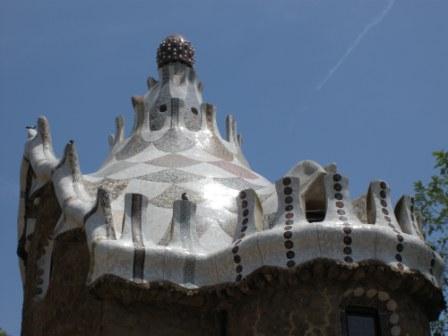 He was a genius.
He was a genius.
We did not get enough of Gaudi at his temple, so we went next to his garden work, Park Guell. Once we left the metro, we made our own route to the park. This had us walking slowly up hilly back streets until we came to the park's entrance.
 Relaxing with a Sangria by the Barcelona beach.
Relaxing with a Sangria by the Barcelona beach.
It was hot and humid, so we were a bit drained after this walk, and Julia had lost all faith in my navigational abilities. But we had just enough strength left to keep on through the park. This paid off, as it was not long before we came across one of Gaudi's finest works: the Park Guell. It is an open-air terrace surrounded by gardens and wonderful views of the city below. True to his style, there is not a straight line to be seen in his creation. What an astonishing structure and how lucky Barcelona is to have it.
The evenings are long and leisurely in Barcelona. One of the reasons for this is that it does not get dark, this time of year, until 10:00 pm. We took advantage of the extended daylight and walked to the city beach. And what should we find there, a Dubai look-a-like building; this one was a W hotel. But we also discovered a completely new dimension of Barcelona: its beach culture. This seems to consist of people of every age surfing, sunbathing, swimming, rollerblading, and generally enjoying the cool Mediterranean breeze - a cool end to our visit to this brilliant city.
Barcelona Video
Wednesday, June 17, 2009: Barcelona - Fustanya, Spain
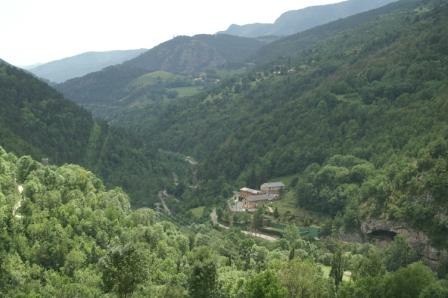 The view from our hamlet.
The view from our hamlet.
A three-hour drive this morning brought us to the Pyrenees. Besides some drama while trying to navigate the maze-like streets and highways of Barcelona, it was an easy drive, all back on the right-hand side, which was rather soothing.
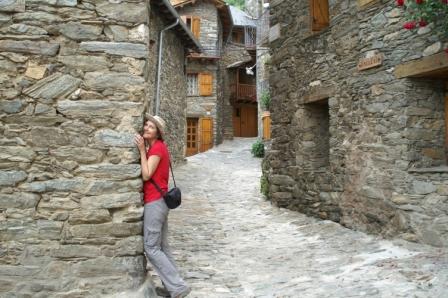 Julia loves old stone streets.
Julia loves old stone streets.
Before arriving at Fustanya, our final destination, we stopped in Ripoll for lunch. Ripoll marked the end of big towns and the beginning of mountain villages. To say Ripoll was a big town would be stretching the truth, but what it lacked in size it exceeded in charm. Stone buildings and small streets opened into squares where one could sit under an umbrella, eating bocadillos and drinking café con leche. Its only other claim to fame was Wilfred the Hairy (yes, that’s his real name), Ripoll being his ninth-century home. Don Hairy went on to become the first count of Barcelona and founded Catalonia! He was known as Wilfred the Hairy because he was, apparently, hairy in places where others were not.
Once our hunger was satisfied, we left Ripoll and drove the winding roads to Queralbs. This is the last town on most maps and the end of the road; after Queralbs, you can continue only on foot or by funicular train to Nuria. At Queralbs, the road turns into a goat track that winds up into the mountains to various hamlets. Our track brought us to Mas La Casanova, our farmhouse accommodation, in the hamlet of Fustanya. Nestled in a green, lush valley offering splendid views of Queralbs, we could not resist taking a walk from our hamlet to the small town. If Ripoll is an 8 on the universal scale of cuteness, Queralbs is a 10. Its medieval stone buildings merge seamlessly into the stone streets and walls, broken only by window boxes full of colorful flowers or giant wooden doors seemingly perfect for keeping out marauding intruders.
Thursday, June 18, 2009: Queralbs - Nuria, Spain
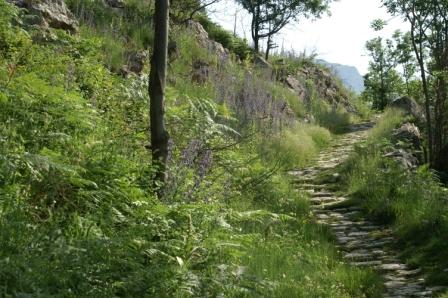 It was an orgy of bees, butterflies, and flowers.
It was an orgy of bees, butterflies, and flowers.
We plodded along slowly for four hours, climbing gradually from 1,000 meters (3,000 feet) to 2,000 meters (6,000 feet) on our hike from Queralbs to Nuria. The hike followed a valley and river most of the way.
 The grandeur of the Pyrenees.
The grandeur of the Pyrenees.
Wildflowers were in bloom, and we saw several stunning waterfalls. We were constantly surrounded by the rugged vertical cliffs of the mountains around us. On the lower section of the walk, the temperature was very warm - 30°C (86°F). Because of this, and the heat generated from the constant climbing, I began to overheat. This had happened to me once before on the Appalachian Trail in Tennessee, so I recognized the symptoms. Fortunately, we came across several cool mountain streams, and I made sure to wet my hat and shirt in them, which really helped reduce my temperature. It was a real shock to put the icy-cold shirt on.
We eventually made it to Nuria, a little village almost completely encircled by tall peaks. The funicular train ends there, there is a nice hotel, and there are a few ski lifts to support skiing in winter. Oh yes, some silly person named James claimed to have had a supernatural experience with a sky god or another imaginary entity, so there is a church there too. Wilfred the Hairy may have visited as well.
Nuria Hike Video
Friday, June 19, 2009: Fustanya - La Seu d'Urgell, Spain
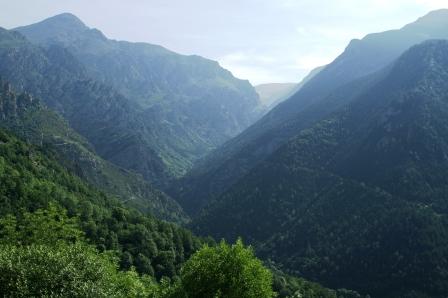 The most stunning Pyrenees.
The most stunning Pyrenees.
We left Queralbs for the border town of La Seu d'Urgell. It took three hours to drive through the astounding Pyrenees Mountains to get there.
Our only stop was in the small border town of Puigcerdà . The road through the Pyrenees rose up to 2,000 meters (6,000 feet) and took us through one of the most beautiful mountain passes I have ever driven through. Heavily forested valleys, grass-covered slopes, and rocky peaks made the drive unforgettable. High-country weather can change quickly, and on our drive, the temperature dropped to 16°C (61°F), and it rained on and off.
 The remains of a very old church in Puigcerdà .
The remains of a very old church in Puigcerdà .
In the little Spanish/French border town of Puigcerdà , we bought fresh fruit for lunch, used an ATM to increase our ever-depleting supply of Euros, and found a Vodafone shop to top up our mobile phone. Unlike Barcelona, this place was not touristy at all but rather a real example of local living.
 Whitewater practice in La Seu d'Urgell.
Whitewater practice in La Seu d'Urgell.
Like so many towns in Spain, its center was full of labyrinth-like streets and the remains of a very old church. In this part of Spain, the language is a mishmash of French and Spanish, and no one speaks English. It took all my meager language skills, and the patience of the locals, to locate the phone shop. I diligently used my translator to write out a complex question. I articulated it to a local, who looked on in horror as I destroyed the pronunciation. Their expression changed from horror to a smile as they tried to fathom my destruction of their grammar. From there, we both resorted to gesticulations and drawing maps, which worked better for everyone.
We soon reached our final destination for the day, La Seu d'Urgell. Once checked into our rather nice hotel, we took a walk around the warren of old streets at the heart of the town. Our destination was a park on the other side. To our complete surprise, we came across an Olympic whitewater training facility. This consisted of a nice park, a small lake, and a man-made river. The river had many sections of differing classes of rapids, and hanging over these spots were gates. We watched with fascination as young men practiced their aquatic skills, dancing with the fast-flowing waters.
Saturday, June 20, 2009: La Seu d'Urgell - La Massana, Andorra
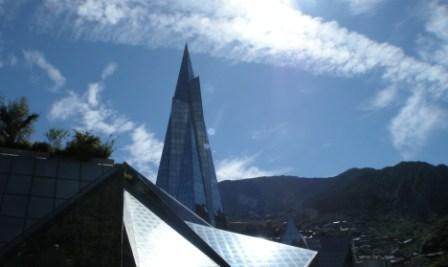 Everything seems new in Andorra.
Everything seems new in Andorra.
It did not take long to drive from Spain to Andorra - just an hour or so. The scenery really changes as you leave Spain.
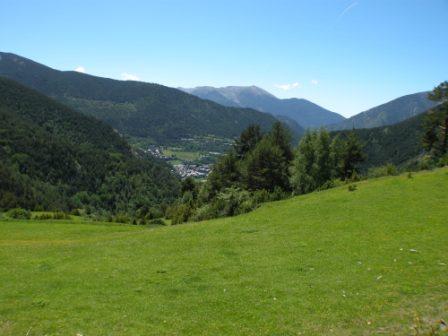 The views are worth the climbing.
The views are worth the climbing.
The Pyrenees Mountains seem distant, but as you drive on into Andorra, the mountains get up close and personal. Andorra is basically a country that sits in a valley surrounded by the tallest peaks of the Pyrenees. Everywhere you go, there are steep cliffs on either side. Because everything is built on or in the cliffs, there is really only one road. However, everything in Andorra seems new and shiny. The buildings and roads look new. Andorra's economy is driven by tourism and banking. The best skiing in the Pyrenees is in Andorra, and I guess the best banking in Europe - nudge, nudge, wink, wink, say no more. Andorra is a parliamentary co-principality with the President of France and the Bishop of Urgell (Catalonia), Spain, as co-princes, in a duumvirate.
Regardless of its politics, it sure is a beautiful place, and in summer, the hiking is spectacular. Julia and I went out for our first walk as soon as we had checked into the hotel. What a pleasure the views and air were. Of course, hiking in Andorra means climbing up and coming down, as there is very little level ground. Still, the exertion was well worth the result.
Andorra Hike Video
Sunday, June 21, 2009: La Massana, Andorra
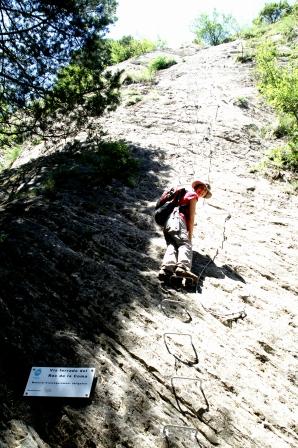 Julia climbing Las Rock De La Coma.
Julia climbing Las Rock De La Coma.
I really will need a new pair of knees after hiking in the Pyrenees. While I am punning, I really adore Andorra. Okay, enough of that. We sorted out another hike on the famous GR-11 trail today. This is the trail that starts at the Bay of Biscay (Hondarribia near Irún) and finishes at Cap de Creus (near Cadaqués), crossing the Pyrenees all the way. On yesterday's hike, we walked on it and wanted to continue today, but we just could not find the trailhead. The biggest problem with hiking in the Pyrenees, particularly Andorra, is that there is very little to no trail information.
And once on the trails, they are very poorly marked. However, we did find another hike, which turned out to be totally amazing: Las Rock De La Coma. This hike was part walk and part rock climb, but we knew nothing of the climbing part until we were right on top of it. We climbed straight up the trail for an hour or so and then climbed out onto the rocks for a bit. As we did not have the right equipment to complete the climb, we turned around and headed back down the way we came. The walk was invigorating and gave us spectacular views of the skiing areas in Andorra. Julia and I will definitely return one day to ski.
Trip stats
Miles Flown: 22,236
Miles Hiked: 232
Miles Skied: 2
Miles Driven: 4,366
Miles Sailed: 110